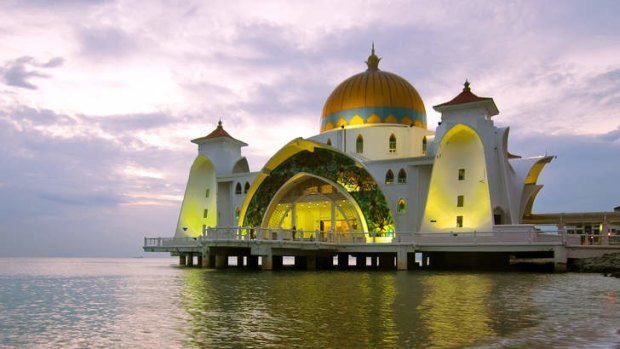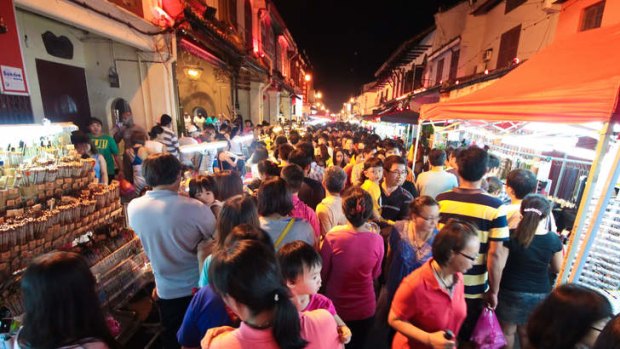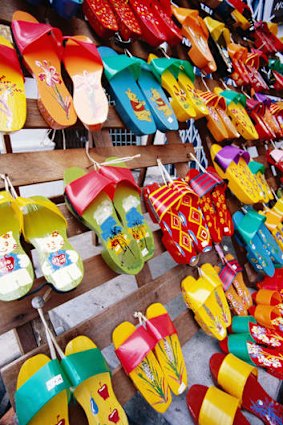
Magic: the Selat Melaka Mosque.Credit: Getty Images
A historic Malaysian city has cleaned up its act, writes Steve McKenna.
If you recall the 1999 flick Entrapment, you'll remember Sean Connery gets to canoodle with a cat-suited Catherine Zeta-Jones. In one scene, Connery's wily art thief and Zeta-Jones's sultry insurance investigator boat down a squalid, slum-edged river, as the Petronas Twin Towers, the conjoined pearl of Kuala Lumpur, gleam in the background.
A box-office smash, the movie helped to revive one of its filming locations: an exotic Asian port city that had fallen on hard times. The footage was actually filmed in Melaka, 150 kilometres south of the Malaysian capital. In true Hollywood-style, the towers were simply superimposed.

Jonker Street at the centre of Chinatown.Credit: Alamy
"The prime minister [at the time, Mahathir Mohamad] was jumping mad when he saw the film," says Ho Peck Choo, my Melakan guide. "He thought it gave a terrible impression of KL. And he was angry with how bad Melaka looked."
Stung, the Melakan authorities cleaned up the river and its banks.
"Things have changed enormously," says Choo, as we stroll prim new boardwalks and promenades, shaded by betel nut palms and lined with guesthouses and al fresco cafes, teahouses and restaurants. The buildings' backs are splashed with giant murals depicting scenes and characters from Melakan history and culture, including bearded sailors and pale-faced temptresses.

Rows of hand-painted shoes in Melaka's Chinatown.
"These buildings were very dirty before; embarrassing when the tourist boats came past," she adds.
The resident historian at Melaka's stylish Majestic Hotel (from which she leads twice-daily heritage walking tours for guests), Choo stresses that the riverside hasn't been completely tamed. Beside a near-abandoned fishing village of battered wooden shacks, we see a chunky monitor lizard rummaging in mangroves.
In 2008, Melaka was jointly awarded a UNESCO World Heritage rating with Georgetown, on Penang, the Malaysian island with which it shares cultural traits - and a fierce rivalry. It was the rise of Penang - along with Singapore and Batavia (now Jakarta) - allied with the silting up of the Melaka River, that signalled Melaka's decline late in the 18th century.
Established about 1392 by a Hindu prince from Sumatra, then seized by Islamic sultans, steamy Melaka (also known as Malacca) hugs one of the narrowest sections of the Straits of Malacca, a shipping route linking the Indian Ocean with the Far East. Nestled at a meeting point of the changing monsoonal trade winds, Melaka's port and meandering river became a hive of Arab, Indian, Persian and Chinese seafarers and merchants, who traded spices, dyes and silk, and injected their genes and memes into local Malay society. Then the Europeans captured Melaka; the Portuguese (in 1511), the Dutch (in 1641), and the British (in 1795). During World War II, the Japanese invaded.
Melaka's multicultural ingredients flavour the city's highly walkable and non-smoking (puffers are fined for lighting up) historic core. On the right bank of a brackish river similar in width to an Amsterdam canal, postcard images vie for attention: the bright red Stadthuys, the official residence of Dutch governors, Christ Church Melaka (founded 1753), a replica of the 15th century sultan's palace, and the ruins of St Paul's, an eerie Catholic chapel-cum-Protestant church atop a grassy hill, from which you can glean sweeping views over the city and straits.
Down below, the Porta de Santiago is the sole trace of a mammoth Portuguese-built bastion, mostly destroyed, with gunpowder, by the Brits. A Dutch-style windmill, a wooden waterwheel and a giant Portuguese galleon (at the maritime museum) are among eye-catching modern additions to the right bank. Melaka's most atmospheric zone, however, is across the river: Chinatown.
With antique curio shops, weekend night markets (selling food and trinkets) and aromatic restaurants dishing up chicken rice balls, fluffy pork buns and cendol (an invigorating dessert laced with shaved ice and cane syrup), vibrant Jonker Street is a must. Chinatown's quieter arteries are also worth exploring.
Dubbed the Street of Harmony, photogenic Jalan Tukang has a Hindu temple, a pagoda-capped mosque, and allegedly Malaysia's oldest Chinese temple. Dating back to 1646, tranquil Cheng Hoon Teng is festooned with gilded Buddhas, mythological figurines and burning joss-sticks.
Once humming with goldsmith workshops and opium dens, the neighbouring alleys are a riot of tin-roofed pharmacies and stores selling shark fins, bird's nests, machetes, meat hooks, teapots, clocks, lanterns, rubber stamps and lacquered boards engraved with gilded Chinese characters. At 56 Jalan Tukong, Wah Aik Shoemakers craft, as souvenirs, minuscule embroidered bound-feet shoes - a relic of the ancient Chinese custom of stunting the growth of young girls' feet (apparently to help secure a husband).
More comfy are Wah Aik's pretty beaded slippers - a symbol of Melaka's Peranakan people. Also known as Baba-Nyonya, or Straits Chinese, Peranakans derived from the intermingling of Chinese migrants and indigenous Malays.
The story is fleshed out at the Baba-Nyonya Heritage Museum on Heeren Street, a Dutch-built road popular with wealthy 20th-century Peranakan families. Characterised by mansions and shop-houses with intricate facades, and courtyards, Heeren Street houses galleries and boutique hotels and a cultural centre dedicated to preserving Melaka's vintage properties.
My favourite aspect of Peranakan culture is the food - a tantalising fusion of Malay and Chinese influences. Nancy's Kitchen (7 Jalan Hang Lekir, off Jonker Street) is a long-standing Nyonya favourite.
Back at the five-star Majestic - set in a refurbished 1920s' Sino-French style mansion formerly owned by a Chinese rubber plantation owner - I rest in a leather-backed armchair, beneath slow-whirring fans, and savour a mini Peranakan banquet. There's pie tee (deep-fried sliced turnip with Merlimau prawn), inche kabin (fried chicken), udang kuah pedas (prawn in spicy sweet-sour broth with fresh pineapple and spices), chap chye (garlicky veg stew) and bubur hitam (black glutinous rice with coconut cream).
I then take a Peranakan cookery class, where Majestic chef Po rustles up his grandmother's recipes: ayam pong teh (succulent chicken marinated in preserved bean paste), udang kuah pedas nenas (prawn pineapple curry) and telur dadar cincaluk (omelette with fermented shrimps).
You can absorb more Peranakan culture in the Majestic's modern wing, with pampering at the in-house spa drawing on Baba-Nyonya rituals. Treatments include palm-sugar and honey body scrubs and bird's nest facials.
I opt for my own DIY wellness session: a warm soak in a claw-footed bath, then a siesta in my four-poster bed.
The writer was a guest of Tourism Malaysia and the Majestic Malacca.
TRIP NOTES
GETTING THERE
Malaysia Airlines and Air Asia fly direct from Sydney to Kuala Lumpur daily; see malaysiaairlines.com; airasia.com. Buses go to Melaka from KL's Bersepadu Selatan bus terminal (two-hour journey); see tbsbts.com.my. There are regular buses to Melaka from KL's international airport, and from Singapore (three-hour journey).
STAYING THERE
The Majestic Malacca, 188 Jalan Bunga Raya. Rooms from 380 ringgit ($126). See majesticmalacca.com.
MORE INFORMATION
Sign up for the Traveller Deals newsletter
Get exclusive travel deals delivered straight to your inbox. Sign up now.